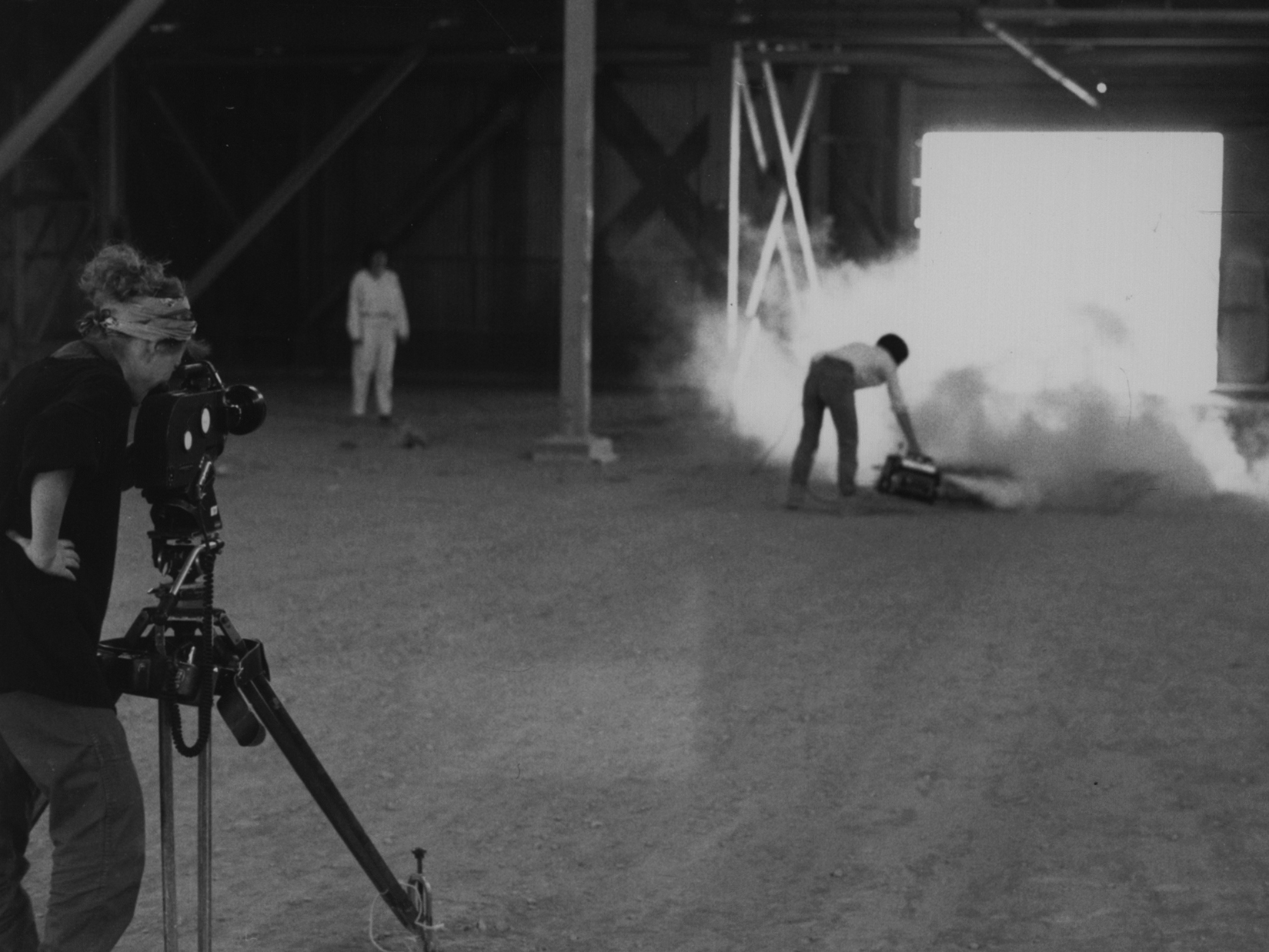
By Elizabeth Block
Describing the work of Lynn Marie Kirby is like trying to grasp a slithery snake sliding around to catch its newest art prey, always exploring and never easy to pin down. Lynn is one of the most rigorous and devoted artists I know. She was my advisor through two MFA degrees at the California College of the Arts and brought me into the school’s Fine Arts department to study film. I was working on my writing MFA, but she saw that I could not contain my filmmaker self and was a fierce ally of my creative process. Although at that point she had already moved into the interstices of video and installation, she recognized my urgent need to get my hands dirty with 16mm film and taught me without demanding that I follow her example as an installation artist (rare among graduate professors to encourage a student on a different trajectory).
Although Lynn is a master with technology who could work in any Hollywood studio or in Silicon Valley, she chooses a distinctly San Franciscan auteur film style. She breaks the boundaries of her tools, experimenting with writing, technology, sound, and the innards of computer machinations with utmost skill and ingenuity.
I never thought of her as a woman filmmaker, but her Canyon films deal with decidedly feminist issues. Her film Sincerely (1980) engages the unfortunately still timely issue of government limitations on abortion, while Sharon and the Birds on the Way to the Wedding (1987) questions the conventions of marriage—even using a parrot to mock these protocols. She places women in front of the camera, (wryly?) questioning female obligations and roles. She does not replicate a male gaze; her protagonists are not decorations to men’s pleasures (maybe even the reverse order). Just being a woman filmmaker with complete skill and direction of the camera marked Lynn as a radical, but she has never made this an issue. She simply loves doing her work.
She came out of the San Francisco Art Institute during an exciting period in its Film Department, studying with the Swedish filmmaker, Gunvor Nelson, and graduating with a group of tight-knit Canyon filmmakers (Sandra Davis, Stephanie Beroes, Jeffrey Skoller, Toney Merritt, Marian Wallace) who helped each other produce work at lightning speed. (This was when San Francisco was affordable, and film was cheap[er]). They eschewed conventional narrative, looking for ways to use film that highlighted the material aspects of the celluloid and drew attention to camera processes. They processed their own films, understanding the chemistry while most filmmakers sent off their negatives to the lab. They performed their own complex optical printing. They were intimate with projectors. They were engineers as much as they were artists. They wanted to use film to make people see and think differently—to change perception and consciousness.
Perhaps Chantal Akerman is one of Lynn’s greatest influences, Michael Snow perhaps another, Yvonne Rainer another. Akerman and Snow with imagery requiring enduring patience, suspense without a narrative resolution. Like looking at a detailed painting. That open space, in itself, is essential to looking, for it invites a subtle awareness, a meditation on image-making. Andrei Tarkovsky might also influence her work, his sculptural landscapes like Kirby’s compulsion for texture, sculpture, and interest in place.
Her close collaborations tend to land with other feminist artists and friends, such as Etel Adnan and Trinh T. Minh Ha. One unusual thread through Lynn’s work is that no matter the media in which she works, she constantly pursues the space of the glitch or the mistake, the mistranslation, to expose the complexity of the form and of the content.
Lynn is a master with sound. She deliberately undermines conventional audio in her early films, overlaying sound like double or multiple exposures. Starting and stopping sound off predictable beats, playing with it, like breaking apart standards of western musical theory.
These strategies compliment her formal image making. For example, Kirby deliberately loads a roll of film into a camera incorrectly, to create a shaking effect in Across the Street (1982). To accomplish this takes specific skill, patience, and a strong understanding of cinematography and how a Bolex camera works. Importantly, the shaky camera matches the content of the film, the story of a woman across the street jumping out of a window. (Even when Lynn tells what on the surface seem to be straightforward or essayistic tales, there is always something complex underneath.)
Upon revisiting Lynn’s Canyon oeuvre, one could wonder why she didn’t expand into narrative filmmaking or essay writing, particularly because Lynn’s Canyon films are beautiful experimental visual essay moments. They demonstrate that her knowledge of world cinema, film theory, cinematography, intellectual history, sound, and literature is encyclopedic.
Yet, Lynn, whose love of cinema and how it works is as promiscuous as mine, took a turn towards the space between film and the art world, or indeed her own site-based art. Perhaps also back to her conceptual-sculptural roots. While I made untrained offbeat films and a standard 30-minute documentary video before I met Lynn, she was the first person who formally taught me and gave me permission to dive into film, and that filmmaking resulted in my own entrance to the Canyon Cinema collection. While I have since followed my theater and literature background toward (and still becoming) narrative film, she has moved into a prestigious international museum world. I still think of her as a mentor. Our conversations about any cinematic form (art and mainstream, as well as new trends in technology) continue.
Recently, we met at her San Francisco apartment to discuss this essay. I talked about my new narrative direction. The conversation turned to streaming movie sites. I mentioned MUBI. She asked if I had seen David Lynch’s Twin Peaks reboot on Showtime. I paused. Yes. She said she loved his use of sound, how he worked with time, the slowness of the narrative, and that this type of work could now be on TV. And I thought, that made sense—Lynch did go to art school. The use of a hearing aid to subvert traditional broadcast audio standards is somewhat novel in narrative film. This reminded me of Lynn’s writing about room tone, that inaudible yet provocative space between sounds.
Yet, Lynn would never take any usual turn. Lynn knows the conventions of art and cinema. She’d rather ask the question “why”? I dare you, try pinning Lynn down. She will have quickly made a splice and edited a new scene.
Elizabeth Block is an award-winning novelist, a Canyon Cinema filmmaker, a produced playwright/director/actor, a poet, and a contributor to The Brooklyn Rail. Her novel, A Gesture Through Time was solicited for feature film adaptation by VOX3. She has presented her writing and film internationally, most recently at Cineinfinito, in Santander, Spain. She is a recipient of a Christopher Isherwood Fiction Fellowship, a Djerassi Foundation Fellowship, and other awards. She was recently a visiting writer at The New School, NYC. Elizabeth has written several short and feature narrative screenplays. She is currently making a short narrative film, What Kind of Woman, under fiscal sponsorship of Film Independent, Los Angeles. The film is being produced by Debbie Brubaker, Daniel McGilvray, and Roselyne Chroman Swig.
General & Title Inquiries
Canyon Cinema Foundation
1777 Yosemite Ave Suite #210
San Francisco, CA 94124


